Last Updated on March 14, 2025
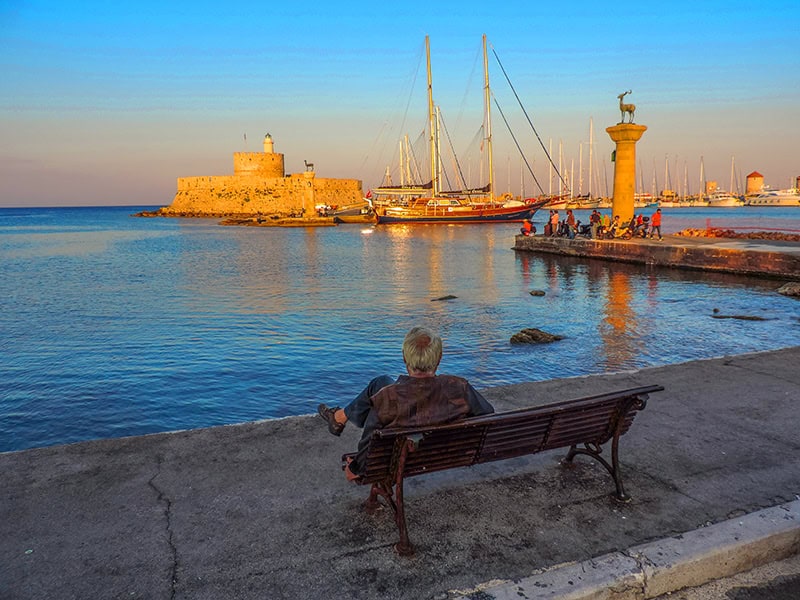
You’ll find plenty of things to do in Rhodes, Greece’s medieval island…
Estimated reading time: 9 minutes
By Jim Ferri
Many people who travel to the Greek islands focus only on popular Santorini and Mykonos. After all, they are iconic islands with whitewashed buildings, spectacular views, and, especially on Mykonos, a vibrant nightlife.

I was as guilty of this as anyone else. After all, who couldn’t fall in love with Santorini’s beautiful views and sunsets? Or Mykono’s wonderful old town?
But to tell you the truth, I’ve fallen in love again with another island. This time, it’s with the island of Rhodes, about 200 miles east of Santorini near the coast of Turkey. Not only is it beautiful, but it also has a strong medieval influence that is still felt today.
I became enamored with Rhodes from the very start as I set off to wander aimlessly about the old city. It’s something I often do when I visit a new place since it’s a great way to get a feel for a place and its people. And on that walk of discovery, I began to realize Rhodes is one of the best Greek islands to visit.
One morning, I was walking along the street when a woman carrying a carton of fresh eggs passed me. I watched with interest as every shop owner she passed called out to her. She acknowledged each with a smile and wave, sometimes tossing a remark back their way.
I followed her further into the labyrinth of shops and restaurants. Above it all, wide shop awnings stretched over the street, providing a welcome respite from the hot Mediterranean sun. I could feel the place slowly charming me since it was unlike any other island in the Mediterranean.
An Astounding Place
Rhodes, the island’s capital city of the same name, is an incredible city still clinging to its Byzantine past.
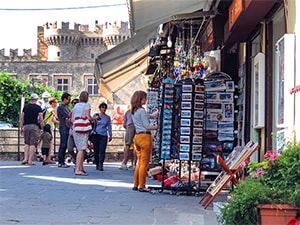
You’ll find the medieval aura here continues to be strong. On some streets, you half expect a knight on horseback to come trotting across the cobblestone lanes. You quickly see it is totally unlike other Greek islands such as Santorini or Mykonos.
Capital of the 12-island Dodecanese chain, Rhodes has a convoluted past. An important trading center in 400 BC, it came under the rule of Rome and part of the Byzantine Empire. Then, in the early 14th century, the Knights of Saint John of Jerusalem conquered it. They turned it into a thriving medieval city.
200 or so years later, Rhodes was seized by the Ottoman Turks and then grabbed by Italy in 1912. Surprisingly, it didn’t become part of Greece until 1948, and in 1988, it was designated a UNESCO World Heritage Site. The designation has helped safeguard the cultural elements and influences of its past that remain obvious today.
A Surprisingly Unspoiled City with Lots to See
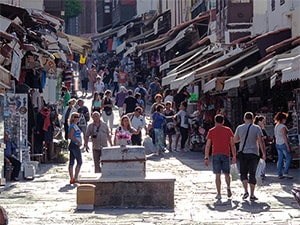
I stayed in Rhodes for three nights at the Rodos Park Suite & Spa Hotela very comfortable hotel on the edge of Old Town. It is near D’Amboise Gate, the most impressive of all Old Town’s gates.
From my hotel, I had an excellent view of the incredible fortress built by the knights. It included a defensive network of two adjacent moats and two massive walls. When I crossed the bridge over the moats, I couldn’t help but marvel at how well-preserved everything was. This included the old city doors at the gate and huge wooden barricades covered with metal plates.
As I delved deeper into the city, I was amazed at its unspoiled interior. Although its old buildings and houses contain many shops, restaurants, and little cafés that cater to tourists, I still felt more like an observer than a tourist as I walked about. And it was all spotless and quiet, without the expected touts pulling on your arm at every turn.
There’s A Lot To Do in Rhodes
Rhodes’ warren of streets and narrow alleys, all lined with medieval buildings, minarets, old houses, tranquil little squares, and fountains, transport you back to other eras. Rarely do you find 24 centuries of history condensed in such a relatively small area.
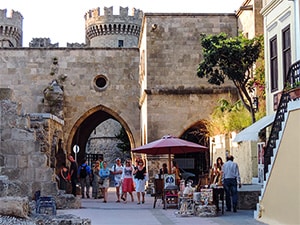
The Palace of the Grand Master, the focus of the old city for many, is near D’Amboise Gate. Originally a 7th-century AD fortress, it was converted in the early 14th century into the residence of the Grand Master of the Order of Saint John by the Knights. Today, it’s a museum of Hellenistic and Roman antiquities.
The adjacent Street of the Knights is one of the best Medieval streets in Europe. Along it are buildings that housed the Knights and medieval inns that housed visitors to the island. I ducked down one alleyway and found, appropriately, a little hotel tucked in a corner.
A Plethora of Historical Sites
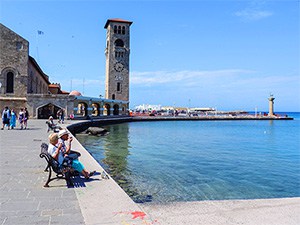
A few blocks from the top of the street is the Mosque of Suleiman. Although now in disrepair, it’s still symbolic of the Turkish conquest in 1523. Around the area, you find other mosques and an occasional bathhouse. Also on the Street of the Knights is the Archaeological Museum, in the former Hospital of the Knights. The Byzantine Museum occupies the former Cathedral of the Knights.
Beyond the museums on the other side of the city walls is Mandraki Harbor. It’s a stunningly beautiful little harbor filled with tour boats and the occasional yacht. Its water is also incredibly clear. Here, the Colossus of Rhodes—one of the Seven Wonders of the Ancient World—once stood. It’s a picturesque place well worth a stroll or even an evening dinner at one of the many restaurants that flood the area on the far side of the street.
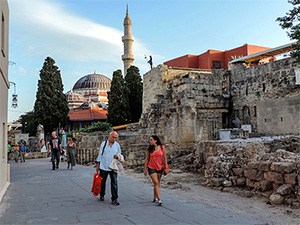
In a Rental Car, Discovering Anthony Quinn Beach
I would have liked to spend more time wandering around the Old Town. But I also wanted to venture further afield and see more of the island.
Taxis charge a flat rate to different towns on the island. Realizing a trip to Lindos would be €62 each way—over $200 for the round-trip—I arranged for a small car rental at my hotel for a flat rate of $35. “The tank is only a quarter full,” the agency owner told me. “Just bring it back with about the same amount of petrol.”
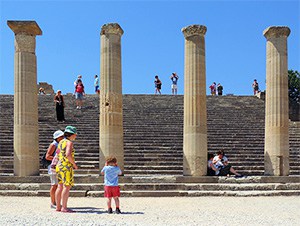
Driving along the island’s east coast, I passed many resorts sprinkled along the shoreline, popular with vacationing Europeans. I sped past them, but when I saw a sign for Ladiko Beach, I turned down the little road and headed for the coast.
At Ladiko is Anthony Quinn Beach, so named for the actor since some of his 1961 adventure The Guns of Navarone scenes were filmed here. I found two beautiful little bays divided by a small promontory, a gorgeous place to sunbathe along the clear turquoise water.
On to Lindos
The real intent for my drive, however, was to visit the little town of Lindos, once a powerful and wealthy village. Soon after leaving Ladiko, I saw it when I came around a bend and was rewarded with a beautiful view of sugar-cube-like buildings climbing from the bay to an ancient Acropolis.
Lindos turned out to be a fantastic little village that now survives only on tourism, which is fine since they keep the place clean and tidy and don’t try to rip you off too much.
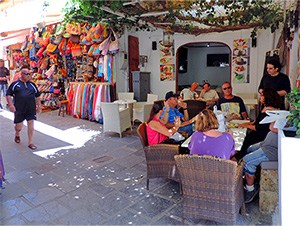
The village is a maze of little lanes, some only a few feet wide, heading uphill towards the ancient fortress and Acropolis 380 feet above the sea. Walking along them in the bright sun, past shops where brilliantly colored clothing hung on the white walls, I sometimes felt like I was walking in a rainbow.
Since I wasn’t feeling intensely energetic, I had planned to take a donkey to the top but missed the place where I was to hire one. Since I was so close to the start of the walkway leading to the top, I just followed the line of walkers instead.
The climb was steep, and there were a few moments when I contemplated heading back down for a burro. But when I got to the Acropolis, I realized the view across the sun-speckled Mediterranean was well worth the effort.
You may also enjoy: Greece’s Incredible Monasteries of Meteora / Corfu, A Very Different Greek Island / 2 Days in Athens, a Captivating City
If You Go:
Greek National Tourism Organization
305 East 47th Street
New York, NY 10017
www.greektourism.com
[email protected]
Tel: (212) 421-5777
Rodos Park Suites & Spa Hotel
Riga Fereou 12
Rhodes 851 00, Greece
Tel: +30 2241 089700
[email protected]
http://rodospark.gr/wordpress/

hello there!
this is truly a motivating! Rhodes will definitely be my next destination as I love ancient cities, and all the history that goes with it!
what time of the year did you go?
regards
Judy
Hi Judy,
I went in May. It was still off season and the prices and crowds were lower. It’s a good time to go — late spring or anytime in the fall. Just watch out for the British school holidays.
On a day trip off our cruise ship three years ago, my wife and I went for a walk not far from where the statue of the Colossus would have been erected at the harbor. Lots of stray cats abounded. Then we noticed this narrow gate that lead us to the moat and we just walked in there. After a while, it got somewhat eery as there were no one around, no sound of modern life, as if we were in a zone as it had been hundreds of years ago. For 30 minutes or so we walked straight ahead and then a very large german shepherd zipped by, which we took as a signal to get back to the street, any street for that matter. We found a small opening in the thick wall of the fortress, no higher than three feet and we got back onto a shopping street. Fascinating experience Rhodes can offer!